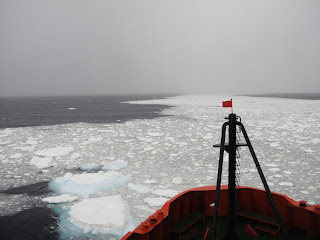The Laurence M. Gould (our vessel) has to stage about a mile away from the camp due to a lot of varying bathymetry near the camp landing. Thus the researchers and all their supplies (equipment, food, etc) are transported by zodiacs (inflatable rubber boats about 20' long). Opening the camp is a long process (around 6 hours or so) involving everybody on the boat (whether its carrying gear from the beach to the camp, shoveling snow, holding the boat in the surf zone at the beach) and more than a dozen back-n-forth trips by the zodiac. Obviously, we need a nice weather window in order to accomplish this and unfortunately we haven't had that yet since we got here late in the evening on Nov 5th.
 |
| The weather report for the evening of 06 Nov. Windy! |
We spent yesterday in stand by mode waiting for the weather to improve, but by the middle of the afternoon, the conditions had actually gotten worse. We had sustained 50 kt winds, the seas were quite large, and as Mike Goebel (who's worked at this camp for 21 field seasons) said “once the seas get spun up like this, they stay up for a while.” So the scientists on board met with our Chief Scientist (Ann Bucklin) and came up with a plan. We'd steam south and try to occupy one of our interior stations (which might be a bit more sheltered) and see if conditions were better as Station 22 is in a bit of lee from some islands at the northern end of the Gerlache Strait. Several of us got up around 530am this morning, went up to the bridge and met with the Captain and our Marine Projects Coordinator (Jullie) to discuss whether we would be able to do any science here. The seas were still pretty good size, but the wind was blowing a steady 30 kts which would mean if we tried to launch (and recover) our net systems, there's a good chance we'd tear or lose them. While we carry spares of most of our systems on board the vessel, there's no benefit to risking equipment this early in the cruise.
So we are now heading to Palmer Station (originally our 2nd stop on this trip) to offload several people who are working at the station for the duration of our cruise (or longer). We'll be there for a full day as there is a lot of cargo that needs to be moved on and off the ship. We'll attempt to calibrate our acoustic systems (if the weather is decent) and set off in another day to head back up north towards Livingston Island and start doing science.
And what about Mike Goebel and his field team (Keven, McKenzie, Jay, Nicole) ? They are stuck aboard the ship until we can find a weather window where we can put them into their field camp. Hopefully after Palmer Station, we'll be able to drop them off and move their gear in better conditions. But in the meantime, they have all been deputized as Assistant Salp Scientists and may give us a hand with some of our sampling until we get them where they are supposed to be.
Keep your fingers crossed for some better seas and winds for us!
Joe



No comments:
Post a Comment